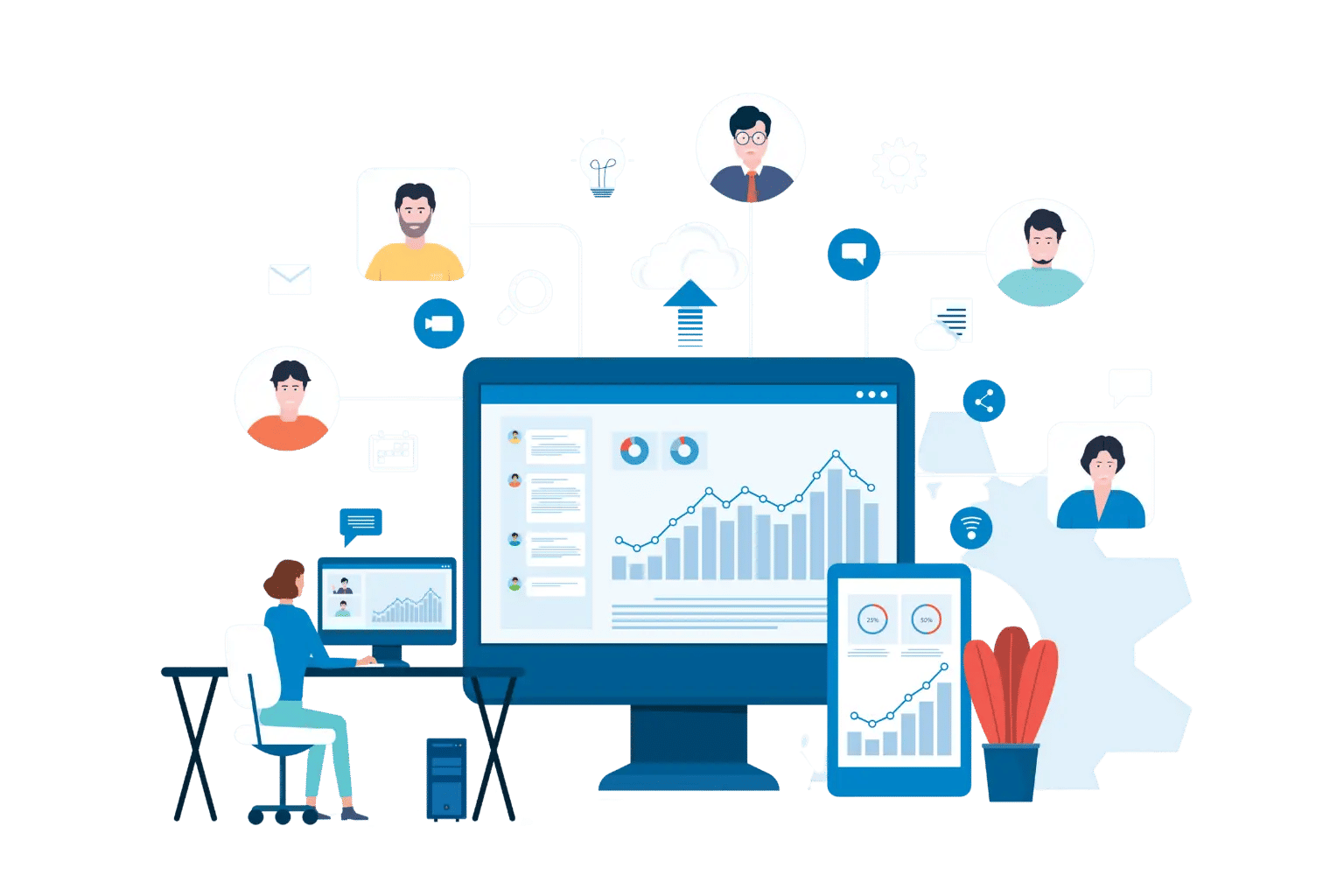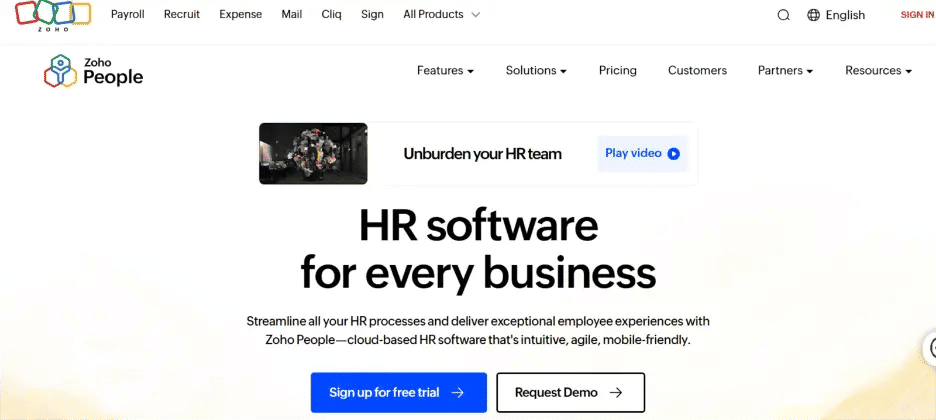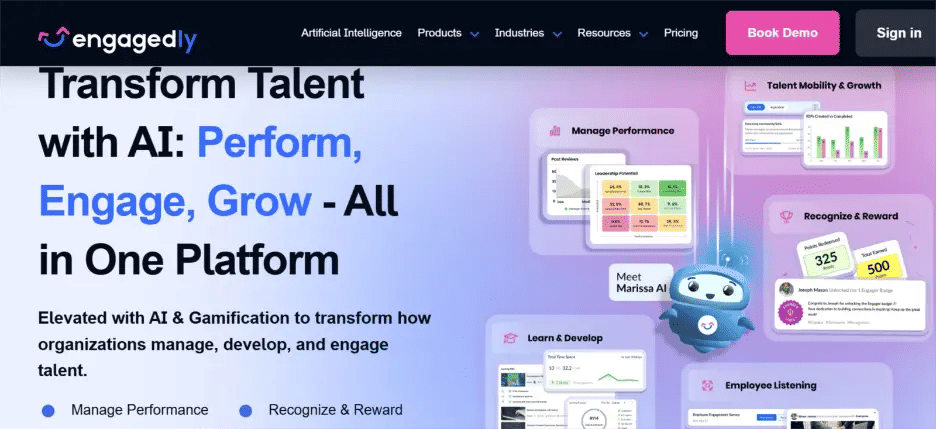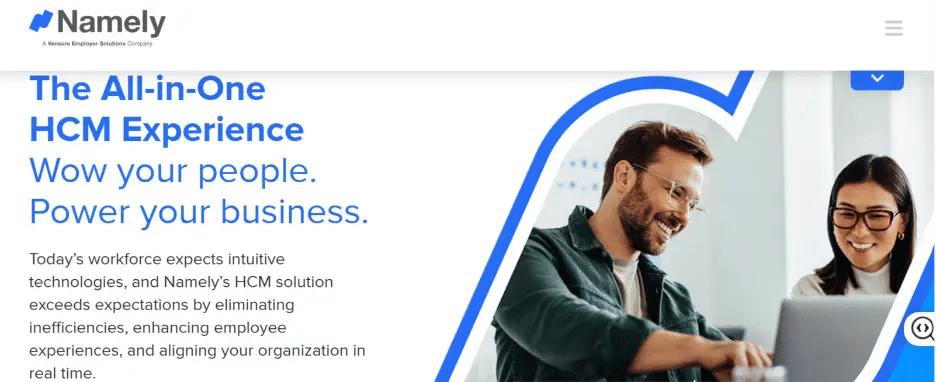
Top 10 Employee Management Software That Will Transform HR Practices
Effectively managing a workforce goes beyond just tracking attendance it involves creating an organized, efficient system that fosters collaboration and drives productivity. Employee management software is a key tool for HR teams, offering a centralized platform to automate processes, improve communication, and track performance seamlessly. As noted by People Managing People, the right software can reduce operational costs by up to 20%, making it a crucial resource for modern HR teams.
In this guide, we explore the top 10 employee management software options that are transforming HR practices. These tools help HR departments streamline daily tasks, enhance team coordination, and ensure smooth management of their workforce. From tracking work hours and employee performance to facilitating better communication and feedback, these software solutions provide comprehensive support for HR teams, enabling them to focus on growing their organization rather than managing administrative tasks.
✨
Quick Read
Summary generated by AI, reviewed for accuracy.
Corporate skilling software helps businesses train, upskill, and retain employees with smart, role-based learning tools. It automates training, tracks progress, supports compliance, and personalizes learning for each employee—whether they are in-office or remote. With mobile access and real-time analytics, it ensures everyone learns what they need, when they need it.
From onboarding to leadership development, corporate skilling tools boost productivity, close skill gaps, and align learning with business goals. The result? A future-ready workforce that adapts fast, performs better, and stays longer—powered by data-driven, digital learning.
By implementing the right employee management system, companies can improve employee engagement, reduce errors, and create a more connected and productive work environment. Let’s dive into the best software options that will help elevate your HR processes.
What is Employee Management Software?
Employee management software encompasses a suite of tools designed to assist HR teams in overseeing employee information, monitoring performance, and streamlining everyday HR functions. These systems automate essential tasks such as scheduling, attendance tracking, and employee data management, freeing up HR professionals to focus on more strategic objectives. The most effective employee management software consolidates all employee-related processes into a single, easy-to-use platform, improving efficiency, and simplifying HR operations.
By centralizing key HR activities, this software ensures that businesses can maintain accurate and up-to-date records, enabling better decision-making and smoother communication across departments. With features like real-time feedback, performance evaluations, and leave management, employee management software plays a crucial role in fostering a more engaged, organized, and productive workforce.
What to Look for in Employee Management Software?
When selecting the right employee management software, it’s important to keep in mind the specific needs of your business. Not all solutions are created equal, so understanding what features matter most can make a significant difference in the software’s effectiveness. Below are some key factors to consider when evaluating your options:
1. Ease of Use
The software should be intuitive and user-friendly. HR professionals and employees should be able to navigate the platform without a steep learning curve. An easy-to-use interface can significantly reduce the time needed for training and increase adoption across your team.
2. Customization
Every business is different, and your HR needs may vary based on industry, company size, or specific policies. The best employee management software allows for customization, so you can tailor it to fit your organization’s unique requirements, including setting up customized workflows, reports, and permissions.
3. Scalability
As your business grows, your HR needs will likely expand as well. Choosing software that can scale with your company will help ensure that you can continue to manage employees efficiently even as you add more team members. Look for software that supports scaling features, such as employee data management, performance reviews, and more.
4. Integration with Other Tools
Most organizations use a variety of tools for various purposes whether it’s accounting software or collaboration tools. The ability to integrate employee management software with your existing systems can save time and reduce the risk of errors. Look for a platform that supports seamless integration with your current technology stack.
5. Automation Capabilities
Employee management software that automates mundane tasks, like time tracking, performance reviews, and leave management, can free up your HR team to focus on more strategic activities. Automation can reduce errors, enhance efficiency, and improve employee satisfaction.
6. Reporting and Analytics
The software should provide detailed reports and analytics to help you track key HR metrics. From performance trends to employee turnover rates, having the ability to generate reports quickly can support better decision-making and enable HR professionals to act on data more effectively.
7. Security and Compliance
HR systems handle sensitive employee data, so ensuring the software has strong security features is a must. Look for platforms that prioritize data encryption, secure access controls, and regular security updates. Additionally, the software should help you stay compliant with labor laws and other industry regulations, reducing the risk of penalties.
8. Employee Self-Service Features
Allowing employees to access their own data, request time off, and update personal information through a self-service portal can save time for HR teams and empower employees to take charge of their information. This feature can improve employee satisfaction and reduce administrative burdens on HR.
9. Customer Support
Having reliable customer support is essential when using any software, especially when it comes to managing your workforce. Ensure that the software vendor offers excellent customer service with responsive teams available to assist with any issues or questions that may arise.
10. Mobile Access
In today’s digital world, employees often work from various locations or may need to access HR systems while on the go. Employee management software with mobile access makes it easier for HR professionals and employees alike to manage tasks like time tracking, approvals, and performance reviews from their smartphones or tablets.
Why Employee Management Software is Crucial for HR
As companies grow, the complexity of managing a workforce manually becomes increasingly challenging. HR departments often face difficulties such as tracking attendance, ensuring accuracy, scheduling shifts, and maintaining employee records. These challenges can lead to human errors, inefficiencies, and wasted time. Without the right tools, HR teams can struggle to keep up with the demands of a growing organization. Employee management software provides an all-in-one solution that simplifies these tasks, helping HR teams save time, reduce mistakes, and increase overall productivity.
The Changing Role of HR
The role of HR has evolved significantly. It’s no longer just about administrative tasks like payroll and compliance it’s about fostering a healthy organizational culture, enhancing employee engagement, and aligning the workforce with company goals. HR employee management software allows HR professionals to transition from administrative functions to more strategic, value-added activities that contribute to overall business success. By automating routine tasks, HR teams are freed up to focus on initiatives like employee development, performance management, and improving workplace culture.
Also Read:- 10 HR Management Software That Will Transform Work in 2025
Key Benefits of Employee Management Software
- Time Efficiency
Employee management software automates many routine administrative tasks such as attendance tracking, performance evaluations, leave management, and document storage. By eliminating manual processes, HR professionals can dedicate their time to more impactful activities, such as strategic workforce planning or employee engagement programs. Automation helps HR teams streamline operations, ensuring tasks are completed quickly and accurately. This ultimately leads to faster decision-making and more efficient business processes. - Improved Accuracy
One of the most significant advantages of using employee management software is the reduction in human errors. Manual processes like tracking employee hours, calculating leave, resulting in costly errors. Employee management software reduces the chances of these errors, ensuring that attendance, and employee records are consistently accurate. By automating calculations and processes, the software minimizes discrepancies, saves time, and improves trust in HR data. - Better Employee Engagement
Employee management software helps foster better communication between HR and employees, as well as between peers. With features like real-time performance feedback, surveys, and recognition tools, HR teams can easily track employee engagement and satisfaction. The software enables managers to set clear expectations, offer continuous feedback, and support employee development all essential elements of a positive work environment. Moreover, employees feel valued and motivated when they receive consistent feedback and recognition for their efforts. - Data Security
HR departments handle sensitive employee information, from payroll and benefits data to personal contact details and performance reviews. Ensuring this data is protected from breaches or unauthorized access is crucial. Employee management software provides built-in security measures such as encrypted data storage, secure access controls, and compliance with privacy regulations like GDPR and CCPA. By using such software, companies can rest assured that sensitive information is kept safe, reducing the risk of data theft and ensuring compliance with data protection laws. - Centralized Platform
Employee management software consolidates all HR-related information into a single platform. This centralized approach helps HR professionals manage employee data more effectively, ensuring that all records, performance appraisals, schedules, and communication are stored in one place. A unified system reduces the need for multiple systems and helps ensure consistency across the organization. It also allows managers to easily access employee data, enabling better decision-making and streamlined HR processes. - Simplified Compliance
Staying compliant with ever-changing labor laws, tax regulations, and industry standards is a constant challenge for HR departments. Employee management software ensures that businesses comply with these regulations by providing tools that track employee hours, manage overtime, and handle benefits administration. The software can automatically update with changes in labor laws, ensuring that HR teams remain compliant without having to manually track legal changes. This reduces the risk of non-compliance penalties and helps HR teams stay on top of their legal responsibilities. - Enhanced Employee Development
Employee management software enables HR teams to track employee performance, identify skill gaps, and plan professional development programs more effectively. Through tools like skill assessments, training modules, and goal-setting features, HR can actively contribute to employees’ career growth. The software also helps track progress, ensuring that employees meet their personal and professional development goals. With continuous learning and development opportunities, employees feel supported in their growth, which leads to higher retention and satisfaction. - Improved Workforce Planning
Workforce planning involves aligning staffing needs with business objectives. Employee management software provides HR teams with the data and analytics needed to make informed decisions about hiring, training, and employee retention. The software can generate reports that identify trends in turnover, absenteeism, and employee performance, helping HR teams proactively manage staffing levels and make data-driven decisions. With these insights, HR can ensure that the organization has the right talent in place to meet its business goals. - Streamlined Recruitment and Onboarding
Recruitment and onboarding can be time-consuming processes that involve managing a lot of paperwork and communication with multiple candidates. Employee management software can streamline this process by automating job postings, interview scheduling, and applicant tracking. Once candidates are hired, the software helps onboard new employees by providing digital forms, training materials, and a smooth integration process. This allows HR teams to quickly integrate new hires into the company culture and get them up to speed faster.
- 10. Better Employee Retention
By using employee management software to track employee performance, engagement, and satisfaction, HR teams can identify at-risk employees before they leave the company. The software’s tools can help HR gather feedback through surveys, track employee morale, and address any concerns early on. HR can also use this data to design retention strategies, such as personalized career development plans, rewards programs, and work-life balance initiatives. A proactive approach to retention helps reduce turnover and the associated costs of hiring and training new employees.
Key Features to Look for in HR Employee Management Software
When choosing the right HR employee management software, it’s crucial to evaluate which features will best support your organization’s unique needs. The right software can streamline HR operations, enhance productivity, and boost employee engagement. Here are some key features to look for when selecting the perfect tool:
1. Centralized Employee Database
A centralized database allows for easy access and management of all employee information, reducing errors and ensuring data accuracy. Look for a system that consolidates employee details in one place, such as contact information, job roles, and performance metrics.
2. Performance Tracking and Feedback
The ability to track employee performance and provide real-time feedback is essential for improving productivity and employee growth. Look for software that supports goal setting, regular performance reviews, and feedback mechanisms to foster a culture of improvement.
3. Leave and Attendance Management
Managing employee time off and attendance manually can be time-consuming. An automated leave and attendance management feature helps streamline requests, approvals, and ensure accurate time tracking.
4. Self-Service Portal
Employee self-service allows workers to manage their own profiles, request time off, and track benefits, reducing the administrative workload for HR teams. This feature empowers employees and enhances their overall experience.
5. Reporting and Analytics
Data-driven decision-making is crucial for HR teams. The right software should offer robust reporting and analytics to track key performance indicators (KPIs) like employee engagement, productivity trends, and turnover rates.
6. Compliance Tools
Ensuring that your HR processes comply with local, state, and federal regulations is crucial. Look for software that automatically updates with changes in labor laws, ensuring your business stays compliant without the added effort.
7. Integration Capabilities
Your HR management software should seamlessly integrate with other tools your company uses, such as systems, benefits management, or time tracking solutions. Integration reduces redundancy and enhances the overall functionality of your HR stack.
8. Mobile Accessibility
In today’s remote-first world, mobile access to HR software is essential. A mobile-friendly platform ensures that HR teams and employees can access the system anytime, anywhere, for tasks like checking schedules, requesting time off, or viewing performance feedback.
9. Employee Engagement Tools
Features like surveys, feedback, and recognition tools can significantly improve employee satisfaction and retention. Employee engagement features help HR teams assess morale and identify areas for improvement.
10. Onboarding and Training Tools
A smooth onboarding experience sets the tone for new hires. Look for software that offers onboarding workflows, training materials, and task tracking to ensure new employees have a positive experience from day one.
10 Best Employee Management Software That Will Revolutionize HR
1. HRMS 365
HRMS 365 is a powerful employee management software designed to simplify HR processes for businesses of all sizes. With a focus on user-friendliness, it provides a comprehensive suite of features that streamline tasks like performance tracking, employee engagement, time management, and much more.
Key Features:
- Centralized Employee Database: Keep all employee information in one place for easy access and management.
- Performance Tracking and Feedback: Monitor employee performance and provide real-time feedback to ensure growth.
- Attendance and Leave Management: Track work hours and manage employee time off, all with automated updates.
- Real-Time Analytics and Reporting: Gain insights into employee productivity, performance trends, and areas for improvement.
Why It’s Great: HRMS 365 is designed to make HR tasks easier and more efficient, offering an intuitive interface that helps HR professionals manage their workforce seamlessly. By automating key tasks like performance tracking and attendance, it gives HR teams more time to focus on strategic goals, such as improving employee satisfaction and enhancing overall business operations. It’s ideal for businesses looking to improve employee engagement and optimize HR operations.
2. BambooHR

BambooHR is one of the best employee management software solutions designed for small to mid-sized businesses. It simplifies the HR process with easy-to-use features like employee self-service, performance management, time tracking, and reporting.
Key Features:
- Centralized Employee Database: Organize and manage employee records with ease, improving data accuracy.
- Easy Performance Tracking: Set clear goals and track employee progress with a straightforward system.
- Self-Service Portal for Employees: Allow employees to update their personal information, track benefits, and request time off, reducing the administrative load on HR teams.
- Reports and Analytics: Gain insights into workforce data with detailed reports that help inform decisions.
Why It’s Great: BambooHR is an excellent choice for businesses looking to simplify their HR processes. It allows HR professionals to manage employee data, track performance, and handle benefits, all from a single platform. By automating many routine tasks, HR teams can focus more on strategic initiatives, such as improving workplace culture and employee development. Its user-friendly interface ensures quick onboarding, making it a go-to solution for growing businesses.
3. Zoho People

Zoho People is a versatile employee management tool that caters to businesses of all sizes. It integrates seamlessly with other Zoho products and offers a variety of features that make managing employees easier and more efficient.
Key Features:
- Employee Records Management: Easily track employee details, including contact information, job roles, and performance metrics.
- Performance Reviews and Feedback: Foster a culture of continuous improvement by regularly assessing employee performance and providing actionable feedback.
- Leave Management: Automate leave requests and approvals to ensure smooth attendance management.
- Employee Self-Service: Employees can access their personal data, request time off, and update their records without involving HR.
Why It’s Great: Zoho People is perfect for businesses that want an easy-to-use solution for managing their HR processes. Its seamless integration with other Zoho applications makes it ideal for companies already using Zoho’s ecosystem, while its intuitive interface ensures a hassle-free experience for HR professionals and employees alike.
4. Workday

Workday is an all-encompassing solution for large enterprises looking for HR employee management software. It offers powerful tools for human resources, finance, and planning, all on a single platform.
Key Features:
- Workforce Planning and Analytics: Use data-driven insights to forecast labor needs and optimize workforce strategies.
- Talent Management: Identify top performers, track career development, and offer opportunities for growth.
- Performance Tracking: Continuously monitor employee performance to ensure organizational goals are met.
- Comprehensive HR Tools: Workday offers tools for recruitment, payroll management, and benefits administration.
Why It’s Great: Workday is tailored for larger organizations with complex HR needs. Its robust reporting and analytics features provide deep insights into your workforce, making it easier to identify gaps, address performance issues, and plan for future growth. Workday’s ability to integrate finance and HR functions also ensures that your business can make informed decisions based on real-time data.

ADP Workforce Now is one of the most trusted names in HR software. It offers a range of features that simplify HR tasks such as benefits administration, time and attendance tracking, and talent management.
Key Features:
- Time and Attendance Tracking: Monitor employee working hours and automate scheduling to avoid conflicts.
- Talent Acquisition Tools: Manage the entire hiring process from posting jobs to onboarding new employees.
- Employee Benefits Administration: Provide a comprehensive benefits package and allow employees to manage their options through a self-service portal.
- Compliance Tools: ADP helps businesses stay compliant with changing labor laws and tax regulations.
Why It’s Great: ADP Workforce Now is widely respected for its reliability and comprehensive suite of features. It’s an excellent choice for businesses looking for a complete HR solution that covers everything from hiring to benefits management. Its integration with payroll functions ensures that employees are always paid accurately and on time.
6. Gusto

Gusto is a cloud-based HR software solution designed for small businesses. It’s user-friendly and provides a complete suite of tools to manage HR processes from onboarding to employee benefits.
Key Features:
- Employee Benefits Management: Gusto allows businesses to offer health insurance, 401(k) plans, and other benefits to employees.
- Performance Management Tools: Monitor employee growth and offer feedback through performance reviews.
- Compliance Assistance: Gusto ensures your business stays compliant with the latest tax laws and employment regulations.
- Onboarding: Simplify the employee onboarding process with automated workflows and document collection.
Why It’s Great: Gusto offers a seamless experience for small businesses that need an easy-to-use platform for HR management. It provides full compliance assistance, helping small businesses navigate complex labor laws. Gusto is an ideal solution for businesses looking to improve their HR practices without breaking the bank.
7. TeamSense

TeamSense is a mobile-first employee management software solution, perfect for hourly employees. It focuses on improving employee engagement, communication, and feedback, especially for industries like retail, manufacturing, and healthcare.
Key Features:
- Employee Communication Tools: Communicate directly with employees via mobile, ensuring real-time updates and engagement.
- Mobile Access for Remote Teams: Remote workers can access schedules, request time off, and complete tasks directly from their mobile devices.
- Shift Scheduling and Time Tracking: Manage work hours and shifts with ease, while ensuring accurate tracking.
- Employee Engagement Surveys: Collect feedback on job satisfaction and improve team morale.
Why It’s Great: TeamSense is ideal for businesses with hourly workers, providing tools for real-time communication, scheduling, and feedback. It ensures employees remain engaged and connected, even when working remotely or on non-traditional hours.
8. Paycor HCM

Paycor HCM is a comprehensive HR solution that covers everything from recruiting to performance management. It’s known for its ease of use and strong customer support.
Key Features:
- Recruitment and Onboarding: Streamline the hiring process with tools for job postings, interview scheduling, and candidate tracking.
- Time Tracking: Automate time and attendance tracking to prevent errors and improve payroll accuracy.
- Performance Management: Set clear goals, track employee progress, and provide constructive feedback.
- Compliance Tools: Ensure your HR processes comply with industry regulations and standards.
Why It’s Great: Paycor HCM makes HR management effortless, offering a user-friendly interface that simplifies everything from recruitment to performance tracking. Its strong customer support ensures that businesses get the most out of the software, making it a great choice for growing businesses.
9. Engagedly

Engagedly is an employee management software designed to boost employee performance and engagement. It offers robust tools for performance management, learning, and employee recognition.
Key Features:
- Performance Appraisals and Feedback: Regularly assess employee performance and offer actionable feedback.
- Employee Recognition and Rewards: Celebrate achievements and recognize employees for their contributions.
- Learning Management System: Offer training and development opportunities to help employees grow.
- Goal Setting and Tracking: Set company-wide goals and track progress toward meeting them.
Why It’s Great: Engagedly fosters a positive company culture by promoting feedback, recognition, and continuous learning. It helps organizations drive employee satisfaction, engagement, and growth, making it a powerful tool for employee retention and development.
10. Namely

Namely is a comprehensive HR platform that caters to mid-sized businesses. It provides easy-to-use tools for managing HR functions, including performance reviews and benefits administration.
Key Features:
- Benefits Management: Offer and manage employee benefits with ease.
- Performance Reviews and Employee Feedback: Regularly assess employee performance and provide constructive feedback.
- Compliance Tracking: Stay on top of HR regulations and compliance requirements.
- Payroll Integration: Streamline payroll and ensure employees are paid on time.
Why It’s Great: Namely is perfect for mid-sized businesses that want a scalable solution for managing HR functions. It provides the tools necessary to optimize HR practices, ensuring compliance and driving employee satisfaction.
Top 10 Employee Management Tools Comparison
| Software | Best For | Key Strengths | Ideal For |
| HRMS 365 | All-in-one HR management | Centralized database, real-time analytics | Businesses seeking comprehensive HR solutions |
| BambooHR | Small to mid-sized businesses | User-friendly interface, performance tracking | Growing companies needing scalable HR tools |
| Zoho People | Seamless integration | Employee self-service, leave management | Organizations using Zoho suite |
| Workday | Large enterprises | Workforce planning, talent management | Enterprises with complex HR needs |
| ADP Workforce Now | Payroll & compliance | Robust payroll features, benefits administration | Companies requiring strong compliance support |
| Gusto | Small businesses | Payroll automation, benefits management | Startups and small firms |
| TeamSense | Hourly & remote teams | Mobile access, shift scheduling | Industries with hourly workers |
| Paycor HCM | Comprehensive HR functions | Recruitment, performance management | Mid-sized businesses |
| Engagedly | Employee engagement | Performance appraisals, goal setting | Companies focusing on employee development |
| Namely | Mid-sized businesses | Benefits management, compliance tracking | Growing organizations needing scalable HR solutions |
How HRMS 365 Automates HR Processes and Saves Time and Money
Employee management software is designed to streamline HR operations by automating repetitive and time-consuming tasks. This allows HR professionals to focus on more strategic goals while ensuring efficiency and compliance. Here’s how employee management software helps businesses save both time and money:
1. Automated Attendance and Leave Management
Employee management software simplifies attendance tracking by automatically recording working hours and managing leave requests. Employees can request time off through a self-service portal, and HR teams can easily track absences, reducing administrative workload. This automation ensures accurate attendance records and prevents costly errors.
2. Performance Management Automation
With automated performance reviews, goal-setting, and feedback, employee management software helps HR teams track employee progress seamlessly. Managers can provide consistent feedback, set clear goals, and ensure regular performance assessments, eliminating the need for time-consuming manual processes and enhancing employee growth.
3. Streamlined Recruitment and Onboarding
Recruitment processes are automated by handling job postings, candidate tracking, and onboarding workflows. From scheduling interviews to document collection, automation reduces the time spent on manual tasks and speeds up the onboarding process, ensuring new hires are integrated into the company more quickly.
4. Centralized Data Management
By centralizing all employee-related data in one platform, employee management software makes it easier for HR teams to access and manage employee records. This eliminates the need for multiple systems or manual data entry, reducing administrative costs and improving overall efficiency.
5. Compliance Management
Employee management software automatically updates with changes in labor laws and regulations, ensuring that HR processes remain compliant. This reduces the risk of costly compliance violations and helps HR teams stay up-to-date with legal changes without the need for manual tracking.
6. Real-Time Analytics and Reporting
Automated reporting features provide HR teams with real-time insights into key metrics like employee performance, turnover, and absenteeism. These reports help HR teams make data-driven decisions, saving time on manual reporting and enabling more effective workforce management.
7. Employee Self-Service
Self-service portals allow employees to manage their own data, track benefits, and request time off without needing HR involvement. This automation reduces the administrative burden on HR teams, saving time and improving overall employee satisfaction.
8. Time and Attendance Integration
Integrating time tracking with other HR functions, such as performance management and attendance, creates a seamless process that ensures accuracy across all reports. This integration saves time and reduces errors, streamlining HR operations.
Conclusion
Selecting the right employee management software is crucial for optimizing HR operations and driving organizational success. Whether you’re focusing on performance tracking, employee engagement, or streamlining administrative tasks, the solutions listed above can significantly enhance productivity and simplify HR workflows. It’s important to assess your company’s specific needs and choose a software that aligns with your long-term goals.
Are you ready to elevate your HR practices? Schedule a demo today and discover how our solution can empower your organization to reach its full potential.
Join Our Creative Community
Frequently Asked Questions
What is employee management software?
Employee management software helps businesses manage employee data, track performance, handle payroll, and improve communication within the workforce. It centralizes HR functions, making it easier for businesses to streamline their HR processes and ensure efficient management of employee records and performance.
How do I choose the best employee management software?
When selecting the best employee management software, consider factors like your company size, budget, and specific needs (payroll, time tracking, employee engagement). Look for software that’s user-friendly, offers strong customer support, and meets your specific HR needs. The software should integrate with your existing systems, providing a seamless experience for HR professionals and employees alike.
Is employee management software secure?
Yes, most HR employee management software comes with robust security features to protect sensitive employee data and ensure compliance with privacy regulations such as GDPR and CCPA. Look for software that provides data encryption, secure access control, and regular security updates to maintain high standards of security.
Can employee management software be used for remote teams?
Yes, many modern employee management software solutions offer features like time tracking, performance management, and communication tools designed specifically for remote teams. These features ensure that remote employees stay engaged, productive, and aligned with company goals, regardless of location.
How much does employee management software cost?
The cost of employee management software varies based on the features, number of users, and type of solution. Typically, prices range from $5 to $20 per employee per month. Advanced solutions with additional features such as payroll integration or analytics may cost more, so it’s important to assess the value the software brings relative to its price.





_JiluXJRGNl.svg)



















